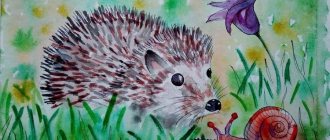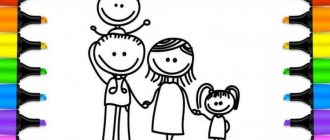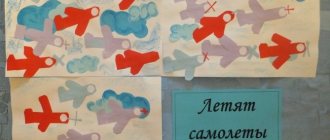What are the benefits of drawing for children 3-4 years old?
Drawing is the most accessible type of visual activity for younger preschoolers. Children of this age explore the world around them with their hands, and art classes provide excellent opportunities to examine various drawing supplies and test them in action.
Moreover, drawing with children 3-4 years old has an impact on their comprehensive development:
- develops fine motor skills of the hand and fingers;
- improves visual perception;
- develops creative imagination;
- affects the development of thinking, memory, attention, speech;
- activates vocabulary;
- has a positive effect on the emotional sphere of the child;
- promotes closer contact between parents and child.
The development of manual skills and color perception are the main achievements of children with whom they regularly practice drawing. Handling a pencil and basic drawing with a brush is what a 3-year-old child should be able to do.
What drawing techniques are suitable
There are some indicative standards for what needs to be taught to a 3-year-old child:
- draw various lines: crossed, left to right, top to bottom;
- use several colors for coloring;
- depict objects that include the connection of two different parts (for example, the rays of the sun) and the rhythmic repetition of the same shape (for example, branches of a Christmas tree);
- use several uniform shapes in the drawing (for example, a snowman).
Anya, 3.5 years old. "Chicks"
You can teach a child to draw the listed elements at the age of 3, using traditional and non-traditional techniques (palmprint, fingerprinting, stamps, lines, blots, splashes, hatching and others).
Shading
Coloring is used to teach the child not to go beyond the contours of the drawing. You can draw balls with your child (circle a glass, draw strings) and offer to paint the circles in different colors.
You can practice both with paints and with a pencil. This is not an easy task for a three year old. But with each attempt there will be fewer and fewer deviations from the contours, and the drawing will become more accurate.
Lines, dashes, spirals
Children's art begins with various dashes and squiggles. However, even in the image of doodles, one should strive for progress and promote the development of graphic skills. Lines - straight, wavy, interrupted - are the basis of any image.
At 3-4 years old, tasks are given in a playful way. Invite your child to draw green grass (similar oblique strokes), a road for a car (a long, relatively straight line), a boat sailing on the sea (wavy lines), a snail (spirals), etc.

Misha, 3 years old. "Sea"
Points
Using dots you can draw a lot of interesting things: snow, falling leaves, rain, peas, berries. Paint (watercolor or gouache) and a “tool” are used to apply dots. These are the child’s fingers, cotton swabs, and foam rubber stamps.
Splashes and blots
If you carefully blow on a large blot with a cocktail straw, it will spread out in an unusual color pattern. This is the “blotography” technique. From such a blot, in the process of finishing the details, you can get a cloud, a tree crown, a lawn. For older children, you can ask the question: “What does it look like?”
The “spraying” technique, which is organized by an adult, is very interesting for preschoolers. He holds a toothbrush in his left hand and puts some paint on it. Then, any flat stick quickly runs along the bristles towards you. Many small dots appear on the paper, with which you can fill the template or create the effect of snow or rain on a finished drawing.
How to interest a child
To attract your child to drawing, you need to think about what motives might prompt children to take up the activity.
Basically, three motives are triggered:
- imitation of an adult;
- interest in drawing supplies,
- the desire to act - to depict something on a sheet of paper.
These are the motivators you should focus on. Show the child how a house, sun, flower, tree, etc. appears on a blank sheet of paper. If the preschooler has already practiced with a pencil, offer him paints or crayons. You may be interested in non-traditional techniques (painting with your palm, finger, branch, tube).
The following techniques will be useful in the future:
- game motivation (for example, a toy chicken enters into a dialogue with a child and asks him to draw her baby chickens);
- artistic word (an adult can come up with a riddle about rain and invite the child to draw it).
With the efforts of an adult, even the most indifferent child will be affected by at least one of the methods. In most cases, children 3-4 years old willingly respond to an invitation to draw.
How to teach a three-year-old to draw a man
A 3-year-old preschooler draws each detail separately. In his opinion, he can connect the two main parts. That’s why three-year-olds’ little men look like “heads.”
A child does not come to such images overnight. First, the baby must learn to confidently draw circles with a pencil. Then he may be “struck by the idea” of drawing two lines extending from the circle. This is already a clear attempt to portray a person, and then you will need the help of an adult to designate the eyes (dots), mouth and nose (dashes) on the face.
It is important to know that three-year-old children depict only those parts that are especially significant to them. Therefore, at first, the little man in their drawings consists only of a head and legs. After the adult shows the baby the details of the face in the drawing, he will also try to depict them.
The eyes and mouth will appear first on the face. A three-year-old child will not remember the existence of a nose for a long time.
Closer to 4 years, the image of a nesting doll or a snowman is taken as a basis. The preschooler draws two circles, one of which is smaller (head), the other larger (torso). Next, the eyes, nose, mouth, arms, legs (dashes) are drawn. Children begin to learn more complex drawings of a person at the age of 5.







